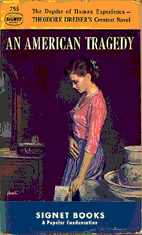
Signet 755
An American Tragedy
by Theodore Dreiser
One of Avati's own
favorites
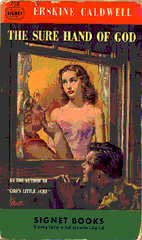
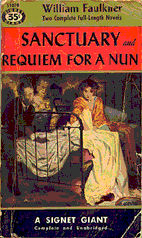
|
|
His colleagues consider him the master of paperback cover art. His
finest period was from 1949 to 1955, when he produced a wealth of brooding,
emotionally–charged paintings for Signet Books.
Born in December 1912 in Bloomfield, New Yersey; he studied architecture
and archeology at Princeton University.
Living in New York in the ‘30s, Avati supported himself by working
at various jobs and was nicknamed “Brother Brush”; he ultimately built
up a reputation as a designer of display windows for Fifth Avenue department
stores.
After his marriage to Jane Hamill and the birth of their first child, Avati
was called up for military service during World War II. He spent 3 1/2
years in the Army, serving as a radio operator in Belgium, Holland and
elsewhere in Europe; in Biarritz, he gave art lessons for several months.
When he returned to America, Avati settled in Red Bank, New Yersey and
decided to go to work as a commercial artist. He did illustrations for
magazines such as McCall’s, Collier’s and Ladies Home Journal, but soon
found such assignments cliched and took a job as a carpenter instead.
In 1948, agent Seymour Thompson put Avati in touch with Kurt Enoch at
the New American Library; the result was Avati’s first paperback cover:
Signet 706, The Last of the Conquerors. Enoch and art
director John Legakes were so impressed with Avati’s style that they
assigned him to produce dozens of additional Signet covers, including
new covers for new printings of books whose original covers had been
illustrated by Robert Jonas. In 1949 and 1950, he also made several
covers for art director Don Gelb at Bantam Books (such as Bantam
766, Jassy, in 1950). An Avati school of paperback art quickly
sprang into being. Illustrators including Geoge Erickson, Mike Hooks,
Cardiff, Stanley Meltzoff, Tom Dunn and Rudy Nappi all began to work
in the dark Avati style. The flood of imitators finally became so heavy
that Avati himself wound up developing a new and different approach
to cover painting.
At one point, Kurt Enoch offered him the position of art director at
Signet, but Avati felt that would entail too much work and he turned
Enoch down. He did, however, serve for a while as consulting art director.
Many of the images on Avati’s covers came from the films he remembered
seeing as a boy. He suggests today that this may be one reason why his
work was so popular among members of his own generation, who shared
his experience of those films. Looking back on this Signet period, his
“Golden Age”, Avati tends to underestimate his own talent: he claims
that his success was, rather, due to, a lucky combination of naivite,
despair and ambition.
He dreamt of becoming a fine artist, but felt that his technique was
inadequate. Like many others, his intention was to use paperback work
as a sort of art school. He painted from photographs which he took himself,
originally hiring models from the Silver Studios in New York and later
taking pictures of ordinary people, nonprofessionals. He even used himself
as a model on occasion..
His paintings were done in oil on prepared hardboard. Finished works
were generally sized about 90 cm x 120 cm (35”x 47”), with the head
of the main figure roughly 6 cm (2 ½”) in diameter. A new world
of stylistic possibilities opened up for Avati when, in 1962, he again
did a cover for Bantam Books. Leonard Leone was art director at Bantam
by tha time, and he encouraged Avati to stop doing fully–detailed paintings
and to concentrate only on essentials. A man and a woman, a chair, the
corner of a bed; those were the important elements, and the rest of
the cover could remain white or could be used for lettering.
Reproduction and printing techniques were more advanced at Bantam, and
this too was an attraction; after more than a dozen years at Signet,
Avati now began working regularly for Bantam. He continued working for
Leone through the ‘60s, and was also able to provide covers for art
director Barbara Bertoli at Avon Books.
Today, his cover paintings are done primarely for Dell and Avon.
His favorite covers are those he did for The Farm (Signet
D1260), An American Tragedy (Signet 755) and The
Woman of Rome (Signet S844).
(from The Book of Paperbacks by Piet Schreuders, Virgin Books,1981)
|
|
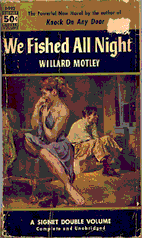
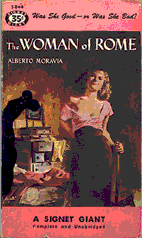
Signet S 844
The Woman of Rome
by Alberto Moravia
A book as dark and brooding
as the cover suggests
|
![]()
![]()

